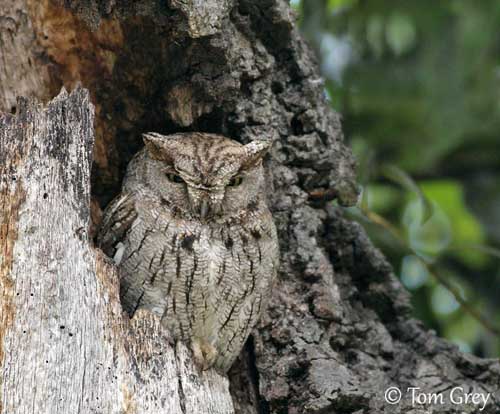
Fr: Petit-duc des montagnes
All : Westkreischeule
Esp : Autillo Occidental
Ital : Assiolo americano occidentale
Nd : Westelijke Schreeuwuil
Sd : Västlig skrikdvärguv
Photographers:
Tom Grey
Tom Grey's Bird Pictures
Tom Merigan
Tom Merigan’s Photo Galleries
Pete Moulton
Pete Moulton Photography
Text by Nicole Bouglouan
Sources:
HANDBOOK OF THE BIRDS OF THE WORLD Vol 5 by Josep del Hoyo-Andrew Elliott-Jordi Sargatal - Lynx Edicions - ISBN: 8487334253
BIRDS OF THE GREAT BASIN – by Fred A. Ryser - Univ of Nevada Pr -ISBN: 0874170796
A GUIDE TO THE BIRDS OF MEXICO AND NORTHERN CENTRAL AMERICA by Steve N. G. Howell, Sophie Webb - Oxford University Press - ISBN: 0198540124
FIELD GUIDE TO THE BIRDS OF NORTH AMERICA - National Geographic Society - ISBN: 0792274512
BirdLife International (BirdLife International)
Owling.com - The largest US website totally dedicated to owls
The Peregrine Fund – World Centre for Birds of Prey
What Bird-The ultimate Bird Guide (Mitchell Waite)
Bird Web (Seattle Audubon Society)
All About Birds (Cornell Lab of Ornithology)
Western Screech-Owl
Megascops kennicottii
Strigiforme Order – Strigidae Family
INTRODUCTION:
Until 1983, both Western Screech-Owl and Eastern Screech-Owl (Megascops asio) were classified as a single species. But their ranges do not overlap. Subtle differences in plumage and vocalizations lead to consider each of them as full species.
The Western Screech-Owl scientific name “kennicottii” pays tribute to the American explorer and naturalist Robert Kennicott (1835-1866). This species was described in 1867 for the first time, and officially called “Kennicott’s Owl”.

DESCRIPTION OF THE BIRD:
Biometrics:
Length: 21-24 cm
Weight: M: 130-210 g – F: 157-250 g
The Western Screech-Owl occurs in two morphs, grey-brown and rufous-buff. The latter is found in N of the range, but it is rare elsewhere.
The grey-brown morph adult has dusky white facial disks, finely mottled grey-brown, and with thin dark margin. The neck is paler, light buff to white. We can see a conspicuous ear-tuft or hornlike tuft of feathers on each side of the head.
The upperparts are grey-brown with dark shaft streaks, more conspicuous on head than on back, and indistinct vermiculations. The upperwing may show a purplish wash. On scapulars, a pale shoulder line is formed by black-edged whitish outer webs. Flight feathers are barred.
The underparts are slightly paler but heavily streaked dark, heavier on breast than on flanks. The streaks are crossed by thin bars or spots.
The bill is blackish. The eyes are yellow. Tarsi are feathered and toes are grey-brown.
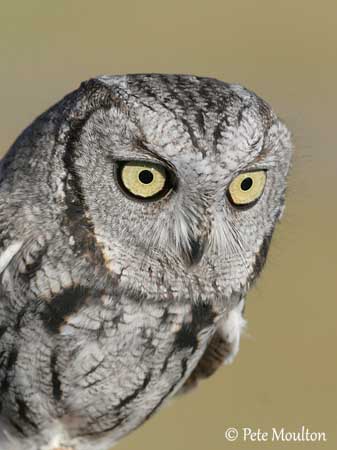
The rufous-buff adult shows similar pattern, but dull cinnamon instead of grey. We can see rufous spotting on breast with black anchor marks. On the head, the face is buff-pale cinnamon.
Both sexes are similar.
The juvenile has deep grey-brown upperparts with indistinct broad dusky bars. The underparts are dull white with broad greyish-dusky bars.
SUBSPECIES AND RANGE:
The Western Screech-Owl has 8 subspecies which differ in colour, streaking pattern and size. However, plumages are highly variable and are usually paler in more arid regions.
O.k. kennicottii (here described) is found on coasts from S Alaska and NW Canada to NW California.
O.k. bendirei is found in E Washington and Montana, southwards to SE California. This race has longer wings than nominate.
O.k. aikeni occurs from SW USA (California E to W Oklahoma), and southwards to N Mexico (NW Sonora). This race is paler grey.
O.k. cardonensis is found in S California and N Baja California. This one is darker and more heavily streaked.
O.k. xantusi occurs in S Baja California. It is almost as pale as “aikeni” and it is the smallest race.
O.k. yumanensis is found from SE California and SW Arizona to N Mexico (NW Sonora). It has pale pinkish-grey plumage.
O.k. suttoni occurs in SW Texas, S to Mexican Plateau. This is the darkest race.
O.k. vinaceus is visible from Mexico (S Sonora and W Chihuahua to N Sinaloa). This one is smaller and paler, with vinaceous wash.
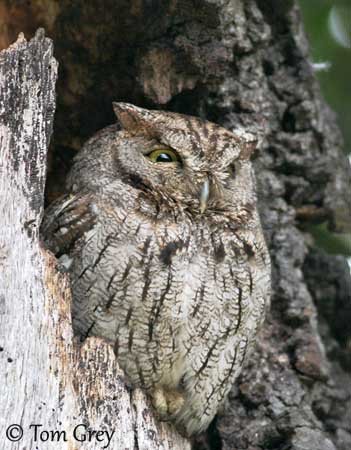
HABITAT:
The Western Screech-Owl is common in open arid to semi-arid woodlands, streamside’s groves, deserts with cacti, semi-open areas with scattered trees and riparian woods, parks and suburban areas.
It prefers open areas with abundance of small mammals and insects. It needs cavities for nesting. It prefers to roost in denser trees, but it may use cavities after leaf fall.
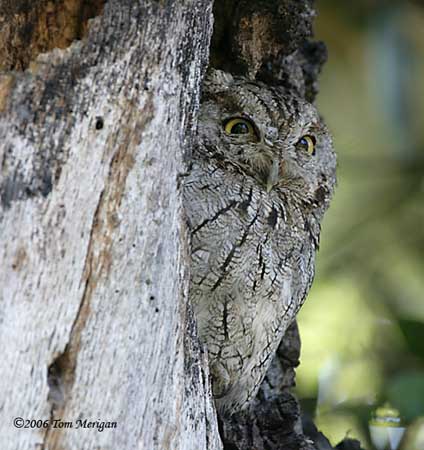
CALLS AND SONGS: SOUNDS BY XENO-CANTO
The Western Screech-Owl’s common call is a series of 5-15 hollow, tremulous whistles on one pitch or descending at the end “oo, oo, oo-oo-oo-oo-oo-oo”. This series starts slowly and then, accelerates in tempo.
It also gives a short trill, followed by a longer one, dropping near the end.
The female has higher-pitched voice. Duets between mates last 2-5 seconds.
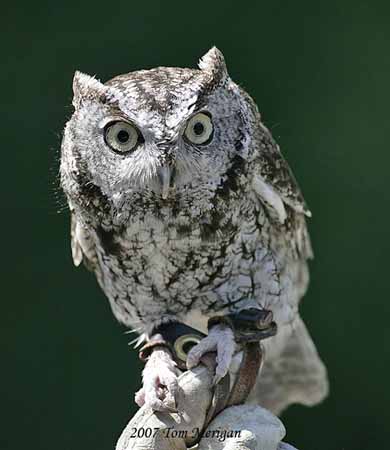
BEHAVIOUR IN THE WILD:
The Western Screech-Owl feeds on various large insects such as grasshoppers, locusts and scorpions, and other species too. It also catches small mammals such as rodents, bats and flying squirrels. Birds, frogs and reptiles are also taken.
This owl is nocturnal, sometimes crepuscular, foraging within 30-45 minutes after sunset. It perches and waits. Once the prey is detected, it drops from the perch onto the prey. It may pursue some of them over short distance. Bats are caught in flight. It also may forage on the ground where it searches for earthworms.
It hunts in open woodlands and at open fields and wetland’s edges. It regurgitates 2-4 dark grey, compact pellets composed of indigestible items.

The Western Screech-Owl becomes more vocal during the breeding season. Male and female perform duets as they approach to each other. When they are together, they perform mutual preening on the head, and they touch their bills. Then, the male utters a rapid tremolo, and the female responds with a shorter one. Courtship feeding is reported too. The male brings food to the female while moving wings and body, prior to copulation.
They nest in abandoned cavities, usually excavated by woodpeckers. They are monogamous and form long-term pair-bonds.
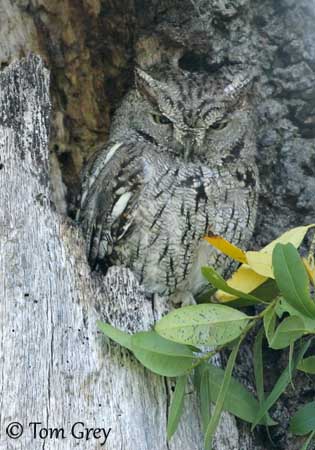
If threatened, the Western Screech-Owl stands erect and slicks its body plumage down. Ear-tufts are held up and the rictal bristles are drawn forwards. By adopting this posture, the cryptic plumage of the owl allows it to blend in with the bark of the tree trunk or the branch where it perches. It remains motionless if disturbed at roost.
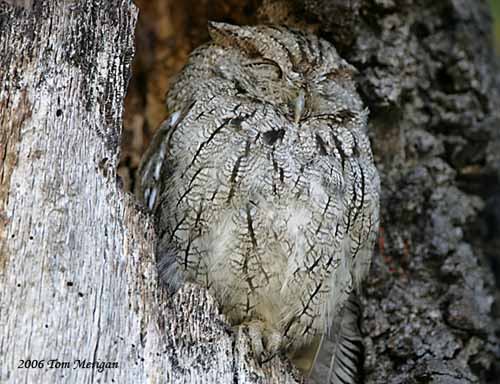
The Western Screech-Owl is mainly resident, but the northern populations are partially migratory. The juveniles often disperse long distances when searching for unoccupied territories.
It has silent flight like all Strigidae species. This flight is enhanced by the typical light wingbeats and the buoyant flight. However, during direct flight, this owl may fly rapidly with steady wingbeats, and rarely glides or hovers. Through wooded areas, it may fly with erratic movements.
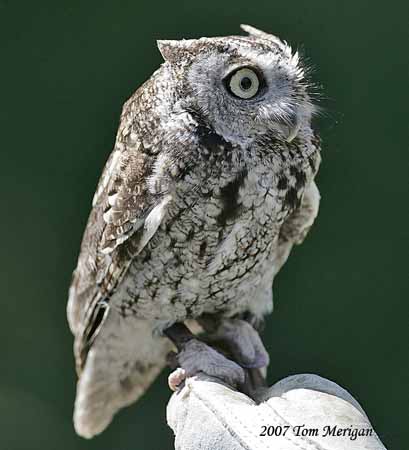
REPRODUCTION OF THIS SPECIES:
The breeding season starts in February/March.
The Western Screech-Owl nests in natural cavities, often an old woodpecker hole or a hole in cliff, in giant saguaro or in juniper along water. The cavity is usually 2-6 metres above the ground, sometimes higher, up to 15 metres.
There is any lining in the cavity, except the natural sawdust on the cavity floor on which 2-5 white eggs are laid. The female incubates during 26 days and broods the chicks while the male provides her some food at nest.
The young fledge about 28 days after hatching. They still depend on parents for 5-6 weeks more, before to be completely independent.
The male defends a small territory around the nest-site during the breeding and the nesting periods.
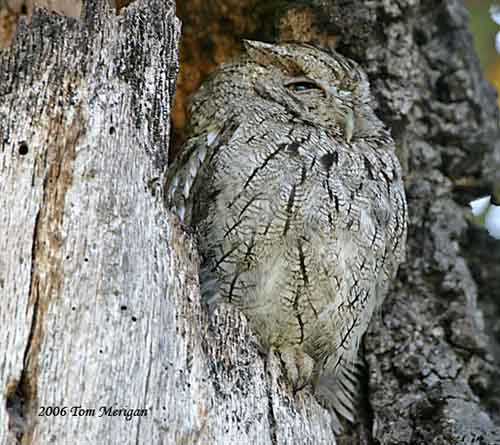
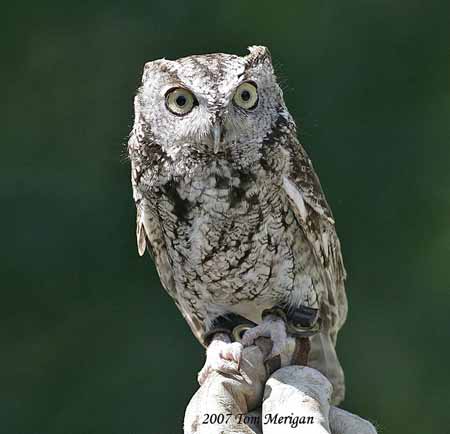
PROTECTION / THREATS / STATUS:
The Western Screech-Owl is fairly or locally common according to the range. In spite of increasing human developments, relatively abundant food resources have led this species in parks and suburban areas where they are numerous today.
The Western Screech-Owl is not currently threatened.